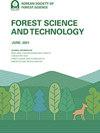Efficient dead pine tree detecting method in the Forest damaged by pine wood nematode (Bursaphelenchus xylophilus) through utilizing unmanned aerial vehicles and deep learning-based object detection techniques
IF 2.2
Q2 FORESTRY
引用次数: 6
Abstract
Abstract Pine wood nematode (Bursaphelenchus xylophilus) is an invasive pathogen in South Korea, where it has caused pine wilt disease (PWD) with extremely high mortality of native pine species (Pinus densiflora, Pinus thunbergii, and Pinus koraiensis). Since the disease spreads by its vectors, native pine sawyer beetles (Monochamus alternatus and Monochamus saltuarius), the cost of monitoring the expansion has been rapidly increasing. Furthermore, it is even more costly to eliminate new and isolated infections since unremoved infected trees act as new sources of infection through the preferred oviposition of the beetles on such trees. The methodology of combining unmanned aerial vehicle (UAV) and object detection based on deep learning provides the opportunity to solve such problems, as UAV with RGB camera can provide high spatial resolution aerial image and digital surface model (DSM), which can be used for object detection with excellent results. In this study, we evaluated the performance of this method to detect dead pine trees in PWD-damaged areas. In particular, to ensure low omission error of monitoring, YOLOv3 was employed for object detection as the model design is focused on minimizing the omission error. We also modified the model so that the positions and crown diameter could be estimated. Four detection models were trained using four different combinations between aerial images (R, G, B) and DSM from UAV. Among them, the model from RGB showed the highest performance (recall: 0.9909, precision: 0.8438) and was selected as the optimal model. Our results suggest that our method can contribute to low-cost and effective monitoring of the dead pine trees while maintaining low omission error, which is critical for PWD management.利用无人机和基于深度学习的目标检测技术,在松材线虫破坏的森林中高效检测死松
摘要松材线虫(Bursaphelenchus xylophilus)是一种入侵性病原菌,在韩国引起了当地松树(Pinus densiflora, Pinus thunbergii, Pinus koraiensis)极高死亡率的松树枯萎病(PWD)。由于该疾病通过其媒介,即本地松切叶甲虫(交替松切叶甲虫和saltuarius松切叶甲虫)传播,监测其蔓延的费用迅速增加。此外,消除新的和孤立的感染的成本甚至更高,因为未移除的受感染树木通过甲虫在这些树上的首选产卵而成为新的感染源。基于深度学习的无人机与目标检测相结合的方法为解决这类问题提供了契机,搭载RGB摄像头的无人机可提供高空间分辨率航拍图像和数字表面模型(DSM),用于目标检测,效果良好。在本研究中,我们评估了该方法在pwd破坏地区检测死松树的性能。特别是为了保证监测的遗漏误差低,模型设计的重点是最小化遗漏误差,因此采用YOLOv3进行目标检测。我们还对模型进行了改进,使其能够估计出位置和冠径。采用无人机航拍影像(R、G、B)和DSM的四种不同组合训练四种检测模型。其中,RGB模型表现最好(召回率:0.9909,精度:0.8438),被选为最优模型。研究结果表明,该方法可以在保持低遗漏误差的同时,低成本、有效地监测枯死松树,这对PWD管理至关重要。
本文章由计算机程序翻译,如有差异,请以英文原文为准。
求助全文
约1分钟内获得全文
求助全文

 求助内容:
求助内容: 应助结果提醒方式:
应助结果提醒方式:


